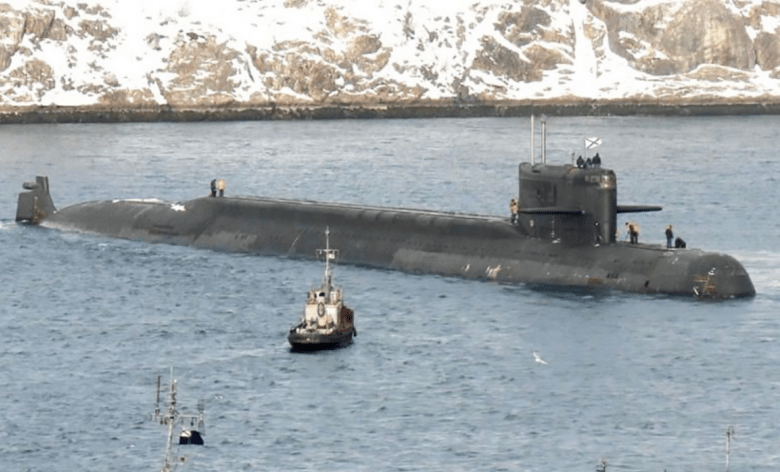On July 8, the Russian Navy took delivery of the K-329 Belgorod, the world’s longest nuclear-powered submarine, the Russian submarine builder Sevmash said in a press statement.
Although exact specifications of the Belgorod have not been publicly released, Naval News reports that the Belgorod’s enlarged Oscar II-class hull is estimated to be 178 meters long and 15 meters across, making the sole Typhoon-class submarine the only larger vessel.
Naval News also notes that Belgorod’s displacement most likely exceeds the 19,000 tons of the original Oscar-II class and is bigger than the largest Western submarine, the US Ohio-class.
According to Sevmash, the Belgorod is designed to tackle scientific problems and conduct search and rescue operations. Moreover, it can serve carriers for deep-sea rescue vehicles and autonomous underwater unmanned vehicles.
Naval News reports that the Belgorod is the first carrier of the Poseidon nuclear-armed underwater drone, which can deliver a retaliatory nuclear second strike at population centers, major cities and industrial centers near the coast by triggering devastating radioactive tsunamis.
The source also shows that it is designed to carry the highly-classified Losharik special mission submarine. Besides carrying the Poseidon drone, The Warzone reports Belgorod can serve as a mothership for various unmanned underwater espionage platforms including the Losharik.
The source notes Belgorod’s reinforced lower rudders, allowing it to sit on the seafloor, and its capability to deploy unmanned underwater vehicles (UUV) that could be used for espionage purposes by tapping or cutting submarine communication cables.
Such a capability can blind or even cripple an adversary, as 95% of global internet traffic passes through these cables, as noted by the Atlantic Council think tank.
Regarding Belgorod’s mission, Russian defense analyst and military expert Alexei Leonkov explained the likely role of the submarine in an interview on Radio 1.
He said that it is designed to launch the Poseidon drone and specializes in second strike missions. Leonkov described the Belgorod as a “retaliation weapon” for a large-scale nuclear war, launching its Poseidon drones in response to a nuclear first strike involving mobile missiles, land-based launchers and land and sea-based intercontinental ballistic missiles (ICBM) against Russia.

Apart from being used as a second-strike weapon, he notes that Poseidon can be deployed against carrier battle groups, with the Belgorod carrying them to the launch site.
However, Poseidon may not be all that Russia touts. In an article in Boennoe Obozreniye, Roman Skomorokhov notes that the US may perceive Poseidon in three ways.
First, the US may dismiss the Poseidon drone as propaganda. He notes that for all the hype it has caused in US defense circles, it may just be a mock-up meant to intimidate the US public and defense planners.
Second, he notes that the US may perceive Poseidon as an underwater research apparatus, but not the nuclear-armed underwater drone Russia claims. Third, the US may perceive Poseidon as a real weapon and initiate research efforts to develop defenses to counter nuclear-armed underwater drones.
For now, strategic ambiguity is probably the most significant advantage Poseidon may give Russia. Skomorokhov notes that while there is logic in building a terrifying weapon like the Poseidon, the truth of the weapon’s existence and capabilities are very difficult to verify.
He also notes that Poseidon may indeed be a doomsday weapon or that it wants to influence the world with such a narrative to prevent an attack against Russia in the first place. In any of these possibilities, he notes that the conflicting narratives have at least likely confused US defense planners.
The Barents Observer reports that the Belgorod will be in experimental operation with Russia’s Northern Fleet before being handed over to the Pacific Fleet. However, there is no mention of where Belgorod will be based during its experimental operation with the Northern Fleet.
The Barents Observer report suggests two possible locations: Severodvinsk, where the Poseidon drone’s development is headed, or Olenya Bay at the Kola Peninsula, where Russia’s other special-purpose submarines are based.
According to the US ODIN military training database, Poseidon is a family of underwater drones rather than a single type. Some units may attack coastal targets, while others may be designed as super-cavitating torpedoes to attack carrier battle groups. The nuclear-armed variant is armed with a low-yield 2-megaton cobalt warhead that can contaminate a 1,700 by 300-kilometer area, making it a weapon of last resort.
The same source states that Poseidon appears to be a robotic submarine 1.6-2 meters in diameter and 24 meters long. It has a top speed of 100 kilometers per hour (kph), a 10,000-kilometer range, and a maximum depth of 1,000 meters – although the drone may operate at 50-100 meters in a low-speed mode for increased stealth.

It can reportedly travel for weeks in low-speed mode to reach its target area before activating its high-speed mode in the last 2-3 kilometers to its target.
Losharik is an unarmed saboteur submarine, according to GlobalSecurity.org. It can dive down to 6,000 meters and is reportedly the Russian Navy’s most silent and hardest-to-detect submarine.
It is designed to lay depth charges at inaccessible locations, conduct surveillance, destroy submarine cables or tap into them. Apart from those roles, it can also perform seafloor studies, submarine rescue and special operations.
As the Losharik is a highly-classified project, there are few details about its specific dimensions. However, the source gives a length estimate of 69-79 meters and a beam estimate of seven meters. It has an estimated displacement of 2,000 tons, is nuclear-powered with a maximum speed of 55 kph and can hold an all-officer crew of 25.


